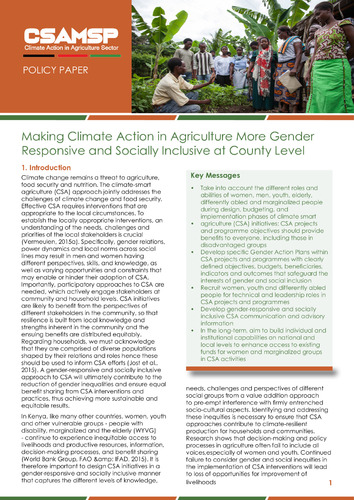Making Climate Action in Agriculture More Gender Responsive and Socially Inclusive at County Level
Abstract
Climate change remains a threat to agriculture, food security and nutrition. The climate-smart agriculture (CSA) approach jointly addresses the challenges of climate change and food security. Effective CSA requires interventions that are appropriate to the local circumstances. To establish the locally appropriate interventions, an understanding of the needs, challenges and priorities of the local stakeholders is crucial (Vermeulen, 2015a). Specifically, gender relations, power dynamics and local norms across social lines may result in men and women having different perspectives, skills, and knowledge, as well as varying opportunities and constraints that may enable or hinder their adoption of CSA. Importantly, participatory approaches to CSA are needed, which actively engage stakeholders at community and household levels. CSA initiatives are likely to benefit from the perspectives of different stakeholders in the community, so that resilience is built from local knowledge and strengths inherent in the community and the ensuing benefits are distributed equitably. Regarding households, we must acknowledge that they are comprised of diverse populations shaped by their relations and roles hence these should be used to inform CSA efforts (Jost et al., 2015). A gender-responsive and socially inclusive approach to CSA will ultimately contribute to the reduction of gender inequalities and ensure equal benefit sharing from CSA interventions and practices, thus achieving more sustainable and equitable results.

